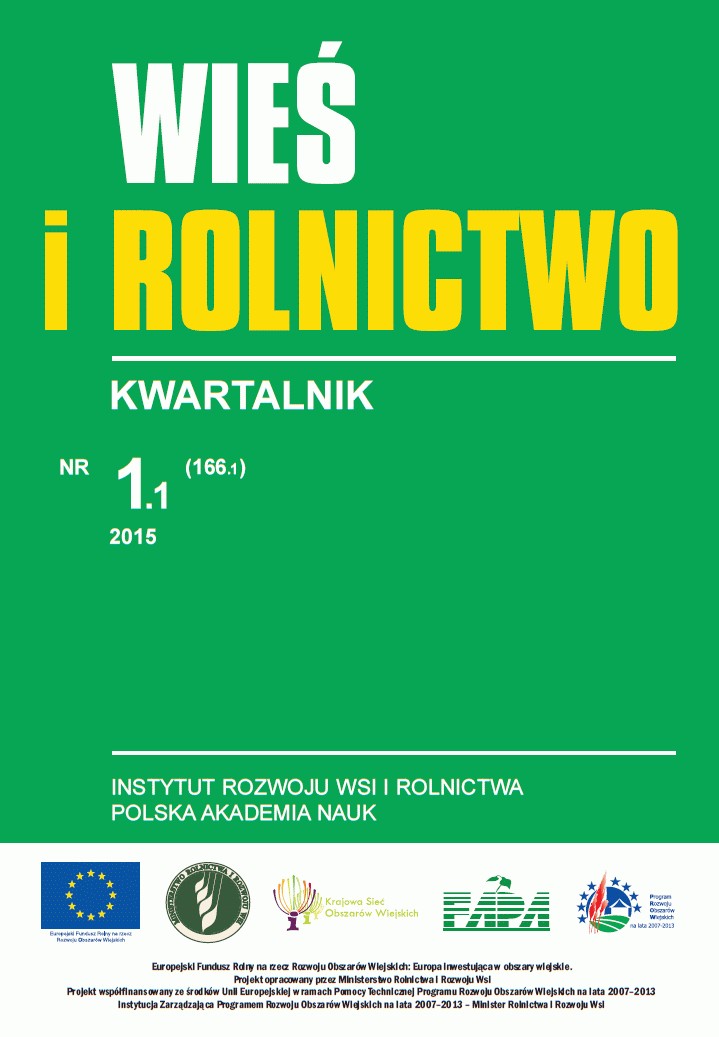Family farms in the EU – their structural and economic diversity and opportunities of growth
DOI:
https://doi.org/10.53098/wir.2015.1.1.166.1/04Keywords:
family farms, criteria of defining, significance and opportunities of development of family farmsAbstract
This paper identifies criteria for defining family farms on the basis of state of the art: definitions for family farms, published in literature.In order to isolate the family farm from the entire population of farms in the EU it has been assumed that the farm should be owned by an individual farmer, it should be the primary place of work and source of income.For the research purposes two levels of farm income per full-time paid employees were examined: income corresponding to the net minimum wage in the country, and average monthly gross wages and salaries. To identify the number of family farms in the EU and the resources they control, both Eurostat and FADN databases were used.In the EU there are 12 million agricultural holdings, including a 11.7 million private farms. Based on the criteria of delimitation, family farms (3.6 million) account for 30% of the total number of farms. They possess more than half (88.3 million hectares) of the agricultural land resource of the European Union. Family farms employ approximately 64% (4.9 million) of the family work units (FWU) and generated 54% (164.7 million) of total agricultural production.This separated group of farms is the potential for development of family farming.References
Bélieres J.F., Bonnal P., Bosc P.M., Losch B., Marzin J., Sourisseau J.M., 2013: Les agricultures familiales du monde. Définitions, contributions et politiques publiques. Montpellier.
Davidova S., Thomson K., 2014: Family farming In Europe: challenges and prospects. In-depth analysis. Corvinus University of Budapest.
Djurfeldt G., 1996: Defining and operationalizing family farming from a sociological perspective. Sociologia Ruralis, 36 (3). DOI: https://doi.org/10.1111/j.1467-9523.1996.tb00026.x
Fennell R., 1997: The Common Agricultural Policy. Oxford: Clarendon. DOI: https://doi.org/10.1093/oso/9780198288572.001.0001
Garner E., Gender P., 2013: Identifying the Family Farm: an informal disscusion on the concepts and definitions. ESW Seminar, Equity and Rural Employment, FAO.
Halamska M., 2014: Współczesne rolnictwo rodzinne: Polimorficzna rzeczywistość i mity. Wieś i Rolnictwo nr 2 (163), s. 25–46. DOI: https://doi.org/10.53098/wir.2014.2.163/02
Kołoszko-Chomentowska Z., Sieczko L., 2014: Gospodarstwo rolne jako podmiot w gospodarce narodowej. Economics and Management nr 1.
Lamarche H., 1992: Wstęp ogólny, [w:] Rolnictwo rodzinne. Międzynarodowe studium porównawcze. Część I. Rzeczywistość polimorficzna. IRWiR PAN, Warszawa, s. 9–24.
Małecki-Tepicht S., 2004: Ocena zasobów pracy w rolnictwie ze szczególnym uwzględnieniem bezrobocia ukrytego w gospodarstwach rolnych. GUS.
Michna W., 2008: Raport o wpływie Wspólnej Polityki Rolnej na tendencje polaryzacji gospodarstw rolnych w ramach poszczególnych makroregionów kraju, Program Wieloletni 1 (93). Instytut Ekonomiki Rolnictwa i Gospodarki Żywnościowej PIB, Warszawa.
Projekt ustawy o rodzinnym gospodarstwie rolnym 1995 rok, http://orka.sejm.gov.pl/proc2.nsf/projekty/1341_p.htm (dostęp: 13.09.2014).
Plan Mansholta – dyrektywa Rady nr 159/72 z 17.04.1972 r. w sprawie modernizacji farm.
Tomczak F., 2006 (dodruk, pierwsze wydanie: 2005): Gospodarka rodzinna w rolnictwie. Uwarunkowania i mechanizmy rozwoju. Instytut Rozwoju Wsi i Rolnictwa PAN, Warszawa.
Traktaty rzymskie; https://polskawue.gov.pl/files/polska_w_ue/prawo/traktaty/Traktaty_rzymskie.pdf (dostęp: 15.09.2014).
Ustawa z dnia 11 kwietnia 2003 r. o kształtowaniu ustroju rolnego. Dz.U. nr 64, poz. 592 – z późniejszymi zmianami.
Zegar J.S., 1999: Gospodarstwo i ludność chłopska współcześnie. Instytut Ekonomiki Rolnictwa i Gospodarki Żywnościowej, Warszawa.
Zegar J.S., 2012: Rola drobnych gospodarstwa rolnych w procesie społecznie zrównoważonego rozwoju obszarów wiejskich. Problemy Drobnych Gospodarstw Rolnych nr 1.
http://ec.europa.eu/agriculture/rica/ (dostęp: 15.09.2014).
http://epp.eurostat.ec.europa.eu/portal/page/portal/eurostat/home/ (dostęp: 15.09.2014).
Downloads
Article file downloads
Pages
How to Cite
Issue
Section
License
Copyright (c) 2015 Wieś i Rolnictwo

This work is licensed under a Creative Commons Attribution 4.0 International License.










